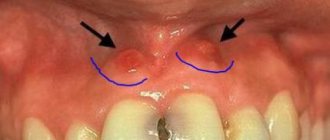To understand what allergic stomatitis , it is necessary to clarify two concepts.
Allergy. An excessive protective reaction of the body's immune system to certain external substances foreign to the body, called allergens. These may be substances that are essentially harmless to humans, but for some people (allergy sufferers) they are perceived by the immune system as dangerous to the body. In immunology, there are several types of allergic reactions, but in practical allergology only type I (fast or instant reaction) and type IV (slow or delayed reaction) are relevant. These types of reactions in the body can occur separately, but they can also occur in parallel. In addition, symptoms similar to those of allergies can be caused by other pathologies, for example, pseudoallergic diseases, conditions of intolerance to certain substances.
Autoimmune diseases. A generalized medical term for pathologies that are based on an excessive reaction of the immune system to the body’s own tissue elements (fragments). That is, the immune system recognizes these elements of the body as foreign and triggers a chain of defensive reactions, leading to severe inflammation and pathologies of various internal organs.
Allergic reactions and autoimmune pathologies can manifest themselves on the oral mucosa and the generalized term allergic stomatitis .
Unfortunately, the relative number of patients with symptoms of allergic stomatitis has recently increased. This is due not only to the fact that the ecology of the external environment is deteriorating or new potentially allergenic components appear in food products. It is believed that a significant contribution is made by the emergence of new and diverse materials used in dental treatment - filling materials, materials for dental crowns and dentures, for the manufacture of braces and implants, various mouth rinses, etc. At the same time, new materials often do not go through the research stage for the risk of allergic reactions. allergic stomatitis may appear and children.
Types of stomatitis
Depending on the nature of the disease and its clinical manifestations, experts divide catarrhal, catarrhal-hemorrhagic, as well as bullous, erosive, ulcerative-necrotic and allergic stomatitis.
The latter, in turn, is divided into the following types:
- medicinal;
- contact, for example, as an allergy to dentures, braces, plates;
- catarrhal;
- catarrhal-hemorrhagic;
- ulcerative-necrotic;
- erosive.
From the point of view of etiology and pathogenesis, allergic stomatitis includes medication, contact (including dentures), toxic-allergic, autoimmune dermatostomatitis, chronic recurrent aphthous stomatitis and other forms.
Depending on the speed of development of the reaction, doctors distinguish immediate and delayed types of allergic stomatitis. In the first case, angioedema is observed, and in the delayed type, the reaction to a particular irritant usually appears a few days after contact with the allergen.
In rare cases, allergic stomatitis develops while wearing dentures. Sometimes a reaction occurs even after 5–10 years of wearing them, after a long asymptomatic period.
Ask a Question
What it is
Allergies can arise in a person out of nowhere, in the complete absence of any reactions to food, medications, dust, pollen and other irritants in the past. This happens due to failures of the immune system, as well as changes at the genetic level. Blood cells responsible for the formation of antibodies to infections at some point perceive a substance that has entered the body as an “enemy” of the immune system. A response begins, which is accompanied by typical allergy symptoms.
A person can calmly eat honey for half his life, drink chamomile tea, and be treated with penicillin. And at one point, any component of normal life can become a strong allergen, which can lead to a powerful reaction, anaphylactic shock and even death. Approximately a third of the world's population is susceptible to one or another manifestation of allergic reactions, and on average, in 20% of this number, allergies manifest themselves as rashes on the oral mucosa. So if you are faced with stomatitis, allergies may be one of the reasons for its occurrence.
Causes of the disease
As is clear from the name of the disease, a negative reaction of the body develops after contact with various allergens. Most often, allergic stomatitis occurs after contact with plant pollen or mold spores. The disease can also manifest itself against the background of:
- installation of crowns, fillings, prostheses made of low-quality materials;
- consumption of certain types of food (especially in children);
- decreased immunity;
- course of treatment with antibacterial drugs or sulfonamides;
- advanced caries;
- bleeding gums;
- inflammation of the oral cavity;
- proliferation of pathogenic microorganisms in the oral cavity.
Sometimes allergic stomatitis manifests itself as a complication of Lyme disease, systemic lupus erythematosus, aphthous stomatitis, hemorrhagic diathesis, and Stevens-Johnson syndrome.
Description of the disease
With the diagnosis described, the oral mucosa is damaged, the tissues become very susceptible to all irritants. The incubation period is long. This means that a lot of time passes from the moment the first signs of allergy appear to the manifestation of the disease itself. Because of this, the patient is unable to track the relationship between the symptoms that bother him.
Allergic stomatitis occurs in both children and adults. More often it is diagnosed in people who live in areas with unfavorable environmental conditions.
Symptoms
The disease is characterized by general and local symptoms. The first symptoms of a mild form of allergic stomatitis are:
- slight discomfort in the oral cavity during hygiene procedures and eating;
- inflammation and swelling of tissues;
- redness and itching of the affected areas of the mucous membrane;
- excessive salivation.
If allergic stomatitis began while taking certain medications, the patient complains of painful blisters filled with liquid. Tick-borne borreliosis is accompanied by redness, blisters on the mucous membranes, as well as bleeding erosions and wounds.
Allergic stomatitis without proper treatment develops very quickly: the patient’s body temperature rises, and bubbles and blisters appear on the skin, mucous membranes of the eyes, and genitals.
If the disease was caused by Lyme disease, red spots with a border appear in different parts of the body and are very painful. Sometimes patients complain of joint pain.
Manifestations of the disease
The disease negatively affects the functioning of the entire body. It doesn’t just cause inflammation of the mucous membranes—it also causes migraines, elevated body temperature, and lethargy. Many people notice dry mouth, severe pain when chewing, which is present even when the integrity of the tissues has not yet been compromised.
Saliva thickens, becomes viscous, more like foam. The gums, tongue, and inner surface of the cheeks may swell. All these symptoms deprive the patient of the opportunity to lead a normal lifestyle.
You shouldn’t wait for the disease to clear up. The sooner her treatment is started, the sooner her health will be normalized.
Diagnostics
The diagnosis of “allergic stomatitis” is made by a dentist based on an examination of the oral cavity and questioning the patient about underlying diseases and medication use. The dentist clarifies the clinical picture of the disease.
The doctor must conduct a comprehensive examination and diagnosis:
- removable and fixed prostheses;
- braces;
- filling
To clarify the clinical picture of the disease, the specialist refers the patient for a comprehensive blood and urine test and an immunogram to assess the state of the immune system. If necessary, the doctor sends the patient for the following studies:
- determination of the acidity level and composition of saliva;
- identification of the activity of enzymes contained in saliva;
- leukopenic test;
- provocative tests with removal and subsequent installation of prostheses.
An integrated approach to diagnosing allergic stomatitis will allow you to quickly find out the cause of the negative reaction, eliminate it and begin effective treatment.
Acute pseudomembranous candidal stomatitis (thrush)
Acute pseudomembranous candidal stomatitis (thrush) occurs:
- Light shape
- Medium-heavy forms
- Severe form
The main symptom of the disease is a white or yellow coating.
With a mild form
The plaque is located in islands, most often on the tongue and cheeks. Children are restless, sleep poorly, and suck the breast sluggishly. Older children may complain of a burning sensation. The plaque is easily removed; underneath there is a bright red mucous membrane. The disease lasts no longer than 7 days.5
Moderate form
The plaque is located on the cheeks, tongue, hard palate, and mucous membranes of the lips. Under the plaque, erosions form, which sometimes bleed. The plaque is more difficult to remove. Lymph nodes are sometimes enlarged and painful. The duration of the disease is 10-15 days, there are relapses.
Moderate form
The plaque is dirty gray, almost cannot be removed, and is located on the tongue, cheeks, soft palate, tonsils, pharynx, and mucous membranes of the lips. Cheilitis appears in the corners of the mouth - inflammation of the lips. The oral mucosa is dry and inflamed. The child’s health is impaired, the child refuses to eat, and the temperature rises. Lesions in the genital area, neck folds, and between the fingers are also common. The disease is long-term, with frequent relapses.
Treatment of allergic stomatitis in adults
If the dentist confirms the diagnosis, he first prescribes complex therapy. It is important not only to eliminate the painful external manifestations of the disease, but also to adjust drug treatment, change the patient’s lifestyle and, if necessary, discontinue medications that caused irritation.
Folk remedies are excellent aids in treating the disease, but using herbal infusions alone will not completely get rid of the disease. The main thing is to determine the cause of the allergy and eliminate it as soon as possible.
The main directions in the treatment of stomatitis are:
- identification and elimination of allergens;
- selection of suitable orthopedic structures (if an allergy to them is identified);
- replacement of low-quality fillings;
- selection of softer and more gentle medications;
- taking antihistamines and antiallergic drugs;
- use of local antiseptics and painkillers;
- disinfection of mucous membranes by rinsing in order to reduce the risk of infection spreading through the bloodstream throughout the body;
- taking analgesics and anti-inflammatory drugs.
Treatment of allergic stomatitis necessarily includes a hypoallergenic diet. In order for the aphthae to heal as soon as possible, and the patient no longer suffers from painful sensations in the oral cavity, the following should be excluded from the diet during treatment:
- sour, spicy and salty foods;
- citrus;
- fried foods;
- peppered dishes.
During treatment, it is recommended to eat soft foods, such as purees or soups. It is important not to injure the affected and swollen mucosa, so that the wounds heal as soon as possible and the swollen mucosa is not injured.
Additional treatment
As prescribed by the dentist and allergist, the patient can use various herbal decoctions and healing oils as additional treatment. The most effective recipes are:
- Aloe juice. The juice of the plant perfectly relieves inflammation, heals ulcers and wounds. You can rinse your mouth with the fresh juice, or you can chew the pulp of the fleshy leaf, peeled.
- Sea buckthorn oil . This oil can treat stomatitis of any form, including allergic ones. You can prepare the oil yourself or buy it at a pharmacy. To supplement the treatment, it is enough to lubricate the affected tissues several times a day. Sea buckthorn will heal wounds, soften the mucous membrane and reduce inflammation.
- Propolis . This beekeeping product perfectly relieves inflammation and heals ulcers and wounds, and also perfectly disinfects the mucous membrane. To treat stomatitis, it is enough to dilute a pharmaceutical tincture of propolis in water in a ratio of 1:10 and rinse your mouth with it.
- Chamomile infusion has excellent anti-inflammatory and wound healing properties. To treat the oral cavity, just pour 2 tablespoons of flowers into a thermos, pour 1 liter of boiling water into them and let it brew for 45 minutes. It is recommended to rinse your mouth with filtered infusion 3-4 times a day. Instead of chamomile, you can use an infusion of sage or calendula, and also prepare a mix, taking a teaspoon of each herb.
Classification of HRAS (chronic recurrent aphthous stomatitis)
| CLASSIFICATION | A COMMENT | ||
| classification: | According to the degree of damage to the mucous membrane: | a comment: | 1) Superficial (catarrhal, fibrinous) 2) Deep (ulcerative, necrotic) |
| classification: | According to the clinical course: | a comment: | 1) acute 2) chronic |
All types of stomatitis occur in children, but the most common are: herpetic, candidal and traumatic stomatitis.
Allergic stomatitis in children
In children, the disease occurs more often than in adults, and at the same time, a weak and fragile child’s body reacts more sharply to irritants. The baby begins to be capricious, complain of pain in the mouth and, of course, is afraid to go to the dentist.
In no case should parents let a child’s illness take its course, relying on traditional methods of treatment. If the baby suffers from allergic stomatitis, no ointments or rinses will cure him 100% as long as contact with the allergen continues. Sensitive thin mucous membranes easily crack, bleed, and pathogenic microorganisms quickly penetrate into the ulcers.
It is important to take the child to a specialist as soon as possible, explain to him that the doctor will help him get rid of the pain, and begin the examination.
Diagnosis and treatment of oral allergy syndrome and itchy tongue reaction
Oral allergy syndrome (OADS), also known as pollen and food allergy syndrome (FADS), is a relatively common allergic/hypersensitive reaction to fruits, spices, nuts and vegetables, and is closely related to allergic reactivity to pollen itself. The most common manifestation of this allergic condition is itching of the lips, throat, gums, mouth and/or tongue.
Dentists may suspect SARP when examining patients who present with complaints of inflammation of oral structures immediately after eating certain fruits, spices, nuts, and vegetables. SARP is not a simple allergic reaction to food because it involves prior sensitization to a cross-reagent, usually pollen, rather than directly to a specific food protein. This pathology is observed in 15-70% of patients with allergic rhinitis to pollen and is more often observed in children than in adults. The prevalence of allergic rhinitis/hay fever caused by pollen ranges from 10% to 30%. Although SARP has a predominantly benign course, some clinicians report the possibility of developing more serious symptoms, which include angioedema, asthma, urticaria, and anaphylaxis. It is known that such complications develop due to IgE-mediated degranulation of mast cells. Symptoms usually progress within a few minutes after eating. Interestingly, carefully preparing foods that trigger CAD symptoms may help eliminate reactive symptoms altogether. Since the main symptom is itching in the mouth, many patients may seek first aid from a dentist. SARP, as a type I immediate hypersensitivity reaction, can develop immediately after ingestion of provoking fruits, vegetables, spices or nuts. Given the presence of certain digestive enzymes in saliva, the initial stage of digestion takes place in the oral cavity and oropharynx, where, in fact, the release of problematic antigens also begins.
Caliskaner et al examined risk factors for the development of SARP in patients with seasonal allergic rhinitis/hay fever. The researchers reported that SARP is more common in women, and also found an association between this disorder and age and the presence of asthma. The study involved 111 patients (78 men and 33 women) suffering from seasonal allergic rhinitis, of whom 16 (14.4%) were diagnosed with SARP. In patients with seasonal allergic rhinitis, the researchers diagnosed the following symptoms of the pathology: nasal congestion, runny nose, itchy nose, sneezing, postnasal drip and olfactory disorders. In addition, some patients were also diagnosed with signs of damage such as headache, itching in the palate, pharynx, eyes, lacrimation, burning sensation and redness of the eyes, itching in the ear canals and stuffy ears. To confirm the presence of atopy, all patients underwent skin prick testing with common allergens, including dust mites, grass, mold, weeds, feathers, and dander. Patients in the study sample who had symptoms of SARP were also tested for reactions to fresh fruit and vegetable allergens. The results of the studies indicated that only the nasal tooth symptom was associated specifically with the pathology of SARP.
Matsson and Möller reported the development of secondary symptoms of gingivitis and rhinoconjunctivitis to birch pollen in children. They tested 34 children aged 8 to 17 years with rhinoconjunctivitis on birch pollen and compared the results with those recorded in healthy children. Children with an atopic reaction to birch pollen had an increased risk of developing gingivitis during the flowering season compared to children from the healthy control group. Ausukua et al also reported that in very rare cases, anaphylaxis can also be interpreted as a complex form of critical development of SARP.
Etiology and history
SARP belongs to the category of disorders classified as “adverse reactions to foods”; it represents a separate nosology and is not analogous to the concept of “food allergy”, which can be mediated by an IgE antibody reaction or a contact form of interaction. All IgE-mediated food allergies fall into the category of direct gastrointestinal hypersensitivity and include type I hypersensitivity reactions such as anaphylaxis and SARP. SARP is an IgE-mediated type I hypersensitivity reaction to pollen associated with subsequent cross-reactivity to food allergens. The reaction develops against specific proteins and includes the production of specific IgE antibodies. During the development of SARP, these specific allergenic proteins are converted into “panallergens”, and IgE antibodies begin to react to both specific pollen antigens and nonspecific plant allergens. SARP usually does not occur in patients without pre-existing pollen sensitivity. These plant panallergens, which are found in vegetables, are involved in plant defense mechanisms against bacteria, parasites and fungi, the most common of which are Bet v 1, lipid transport profiles and proteins. Cross-reactivity can be explained by the presence of shared epitopes both in the structure of pollen and in the structure of food allergens. That is, specific IgE antibodies, which are aimed at identifying pollen antigens, can also recognize food allergens that have the same epitopes. Allergen-IgE complexes bind to the surface of mast cells (and basophils), which causes the release of histamine, leading to the development of symptoms of SARP.
Bohle et al assessed the effects of major allergens following cooking in terms of symptom development and IgE- and T-cell-mediated reactions in vitro and in vivo. They reported that in vivo, after cooking, allergens did not provoke the development of symptoms of SARP, although in some cases there was a worsening of symptoms of atopic eczema. In vitro, researchers have reported loss of the ability to bind IgE and induce mediator release. The most common allergen causing SARP is birch pollen, which is also associated with allergens in fruits such as kiwi, apple, pear, plum, peach, melon, avocado, tomato and cherry, and allergens in plants such as celery, lentils and peas, nuts, hazelnuts, walnuts and almonds.
Other problematic pollen substances that can cause the development of SARP include common weeds, grasses, ragweed, wormwood and parietaria. Kondo and Urisu reported some controversy regarding the definition of SARP, which Almot et al in 1987 described as a type of allergic symptomatology caused by foods associated with positive skin allergic reactions, as well as signs of mucosal lesions. At the same time, Almot did not connect the development of SARP with the cross-effect of pollen. In 1988, Ortolani et al modified the definition of SARP and began working to study the relationship of this disorder with allergic effects to birch pollen. Valenta, Kraft, and Ma defined SARP as pollen and food allergy syndrome to avoid confusion between SARP and other food allergies. SARP was eventually classified as a class 2 food allergy (associated with cross-reactivity to pollen antigen), which was distinguished from a class 1 food allergy (caused by direct intestinal sensitization). Although CAD is not, in fact, a syndromic condition, such terminology is still used to describe this lesion at the present time.
Diagnostics
The presence of SARP should be suspected in patients with a history of pollen allergies who experience signs of tingling or itching in the oral cavity immediately after eating fresh fruits, vegetables, or nuts. Further confirmation of the presence of SARP can be obtained if the patient states that allergic symptoms did not develop after eating the same food, but in a cooked form. SARP-associated symptoms include the development of tingling, irritation, burning and/or swelling sensations in the oropharynx, lips, tongue and palate. The maximum duration of active symptoms does not exceed 1 hour. Signs of injury are usually not serious, although some patients may develop acute localized and systemic reactions, including nausea, vomiting, abdominal pain, diarrhea, eczema, asthma, urticaria and laryngeal edema and, even less likely, anaphylactic shock.
The diagnostic process can be maximally objectified by using strictly controlled double-blind placebo tests. For this procedure, it is important to use only fresh vegetables, the taste of which is quite difficult to mask when using placebo analogues. Prick tests to determine reactions to pollen or certain food antigens can also help with diagnosis. Additionally, a general blood test, determination of the amount of IgE and serum IgE antibodies can be performed. The problems of carrying out such manipulations are associated with some difficulties in interpreting the results obtained, additional costs and the risk of obtaining false positive results. Differential diagnosis of SARP should be carried out with viral lesions of the oral cavity, recurrent aphthae, erythema multiforme, burns and contact allergies to other substances. Treatment of severe manifestations of SARP such as anaphylaxis is carried out in the same way as other anaphylactic reactions, although it should be borne in mind that cases of severe forms of SARP are extremely rare and have not yet been described in the literature.
Case series
Five patients were referred to the dental clinic by a periodontist with a history of symptoms that could potentially be associated with SARP. All five patients had seasonal allergic rhinitis, and all of them reported that they did not experience similar signs of allergic lesions after eating cooked foods. The age of the patients ranged from 32 years to 61 years, and the first symptoms were noted by them in the period from 12 years to 41 years (all but one patient remembered only the approximate time of onset of the first symptoms: 12 years, 23 years, 24 years, 40 years , 41 years old). The age at onset of symptoms in this sample of subjects was significantly higher than previously reported in the literature. In all patients, SARP was manifested by itching and burning and tingling sensations in the tongue, which were associated with eating apples, nuts, avocados, kiwis and other fruits. Because SARP is a benign condition, these patients were not referred for allergy testing. We also did not conduct any additional laboratory tests, since, based on the anamnesis data, the presence of SARP could be confidently assumed in patients. The main diagnostic criteria for diagnosis were: the presence of seasonal allergies, the development of oral itching in the absence of other clinical symptoms and the absence of any symptoms when eating cooked food.
Treatment
Avoiding foods that trigger the development of SARP is the initial stage of treatment. In addition, in the future, patients should be referred for examination to an allergist in order to assess the risk of developing more complex atopic reactions.
Patients may also be prescribed specific immunotherapy against pollen antigens. There is anecdotal evidence that over time, patients with SARP may develop increased tolerance to foods that previously triggered symptoms. However, this information requires careful verification. Given that many food antigens in fruits and vegetables are unstable (heat labile), careful food preparation may help eliminate the symptoms of SARP. In some cases, the doctor may consider prescribing a device for automatic self-administration of epinephrine to the patient. But still, the best treatment is prevention, so avoiding eating foods that provoke the development of SARP is the best method of treating this pathological condition. The second, no less important and effective approach is cooking food at a certain temperature. And the third is the referral of patients with SARP for additional diagnostics to a dermatologist, pulmonologist, allergist and immunologist.
Conclusion
Dentists should be familiar with ARPA as a pathological condition that develops relatively frequently and may present with symptoms of damage to the oral mucosa. In addition, given the specific pathogenesis of SARP, dentists should understand the need to refer the patient to certain specialists and inform the patient about the need to avoid certain foods associated with the development of allergic symptoms.
Authors: Heba Hussein, BDS, PhD Robert K. Mensah, DDS Ronald S. Brown, DDS, MS
Prevention of allergic stomatitis
Unfortunately, patients are not always able to prevent the development of allergic stomatitis. It is impossible to predict what the oral cavity's reaction to a foreign substance will be. If an immune reaction is suspected, the dentist may refer the patient to an allergist.
The main measures to prevent allergic stomatitis are timely visits to the dentist and treatment of caries, strengthening the immune system and using suitable products for daily oral hygiene. If detected early, the pathology can be successfully treated.
If you suspect that you or your child have allergic stomatitis, experience pain in the oral cavity, or find ulcers and aphthae on the mucous membrane, do not delay consulting a doctor. Experienced dentists at STOMA clinics will help you determine the source of allergic stomatitis, quickly get rid of the unpleasant manifestations of the disease and return to your normal life.
We will check all structures in the patient’s oral cavity, conduct allergy tests, and, if necessary, refer the patient to trusted allergists and other specialists.
Call and make an appointment by phone. STOMA clinics are open from Monday to Saturday. You can choose a conveniently located clinic; we are open in many districts of St. Petersburg.
Content:
- Description of the disease
- Manifestations of the disease
- How does allergic stomatitis develop?
- Why does it occur
- Establishing diagnosis
- Fighting the disease
- How to reduce the risk of developing the disease
A dental disease in which the integrity of the oral mucosa is damaged - allergic stomatitis - occurs quite often in medical practice. It comes in different forms, so a person cannot always understand what caused the disease and what factors caused its negative symptoms.
Prevention in infants
Preventive measures should begin in a newborn child immediately after he is discharged from the maternity hospital. For the first days and months of life, it is necessary to adhere to thorough disinfection of toys, bottles during artificial feeding, or to treat the nipples immediately before applying to the breast.
«
An important point is regular visits to the dentist from the first teeth. It is necessary to carefully care for your baby’s oral cavity and use only special toothbrushes and toothpastes, preferably those recommended by the doctor.
Treatment
The main method of dental intervention is replacement of dentures. Ceramics are best suited for fixed dentures. This is a bioinert mass that does not cause allergies. Ceramic dentures make it possible to choose the material to suit your budget. Porcelain structures are cheaper than glass-ceramic ones (E-max, Empress), and they, in turn, are cheaper than zirconium ones. If it is not possible to install ceramics, then you need to select an alloy that excludes metals that cause allergies.
If you are allergic to removable dentures, the composition is also changed. Acrylic is replaced by nylon and Acry-Free polymer.
But in clasp structures you cannot do without metal. Ideally, it would be good to replace the arc and fasteners with inert metals: gold, platinum, titanium. In other cases, dentistry selects a composition that does not contain metals that were in the previous restoration. Another option may be to install a Quadrotti prosthesis. The material of construction is relatively hard thermoplastic. Clasps are also made from it. The absence of metals reduces the risk of allergies.
Anti-allergy treatment (antihistamines) is carried out against the background of dental procedures.











